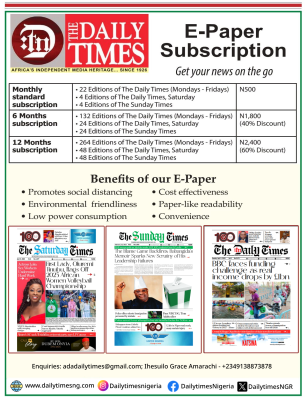Nigeria at 65: From Oil Reliance to Trillion-Dollar Economy Ambition

Sixty-five years after independence, Nigeria’s economic journey tells a story of promise, pitfalls, and persistent ambition. From the discovery of oil that turned the country into a monolithic economy heavily dependent on crude exports, to decades of fluctuating revenues and failed attempts at diversification, successive governments have struggled to steer the nation towards sustainable growth. Today, as policymakers set their sights on building a $1 trillion economy, the questions of how to wean Nigeria off its oil addiction, strengthen non-oil sectors, and tackle structural challenges of inflation, unemployment and insecurity remain urgent.
In this analysis, Group Business Editor of The Daily Times Newspapers, MOTOLANI OSENI, critically examines Nigeria’s economic path, the reforms undertaken, and the hurdles that stand between the nation and its trillion-dollar ambition.
Oil: The Foundation of an Uneasy Prosperity
The discovery of oil in Oloibiri in 1956 marked a turning point in Nigeria’s economic history. By the 1970s, crude petroleum had overtaken agriculture as the primary source of export earnings, transforming Nigeria into one of the world’s major oil exporters. The oil boom of 1973–1974 provided Nigeria with windfall revenues that funded ambitious infrastructure projects, expanded the civil service, and gave the illusion of limitless prosperity.
But oil dependence also sowed the seeds of vulnerability. With oil accounting for more than 90 per cent of export earnings and around 70 per cent of government revenue, the country became dangerously exposed to global price fluctuations. The collapse of oil prices in the 1980s triggered debt crises, currency devaluations, and painful austerity measures. Instead of being a blessing, oil wealth entrenched a “resource curse” marked by corruption, rent-seeking, and neglect of other sectors.
Agriculture: From Glory to Neglect and Renewed Efforts
Before the oil era, agriculture was Nigeria’s economic backbone, contributing over 60 per cent of Gross Domestic Product (GDP) and employing the majority of the workforce. Cocoa from the west, groundnut pyramids from the north, and palm produce from the east were globally renowned. These exports financed regional development and built the foundation of Nigeria’s early economy.
The oil boom, however, led to widespread neglect of agriculture. Successive governments attempted to revive the sector, launching programmes such as Operation Feed the Nation under General Obasanjo in the late 1970s and the Green Revolution under President Shagari in the early 1980s. More recently, initiatives like the Anchor Borrowers’ Programme (ABP) sought to empower smallholder farmers and reduce food imports. While pockets of success have been recorded, insecurity, poor infrastructure, and low mechanisation continue to hinder large-scale transformation.
Industry and Manufacturing: Motion without Movement
Nigeria’s industrialisation agenda has struggled to move beyond rhetoric. Import-substitution industrialisation policies of the 1970s and 1980s encouraged local manufacturing, but structural bottlenecks quickly stifled growth. Erratic electricity supply, high interest rates, smuggling, and weak infrastructure left domestic industries unable to compete with imports.
Even today, manufacturing contributes less than 10 per cent to GDP, despite Nigeria’s vast consumer market. Sectors such as cement production and food processing have thrived under targeted policies, but broader industrial growth remains elusive. The vision of Nigeria as Africa’s manufacturing hub has yet to materialise, and the challenge of building competitive industries lingers.
The Banking Recapitalisation Revolution
Nigeria’s banking sector reform has entered a new phase, one that could prove pivotal for the country’s broader drive toward a $1 trillion economy. The Central Bank of Nigeria, in March 2024, introduced new minimum capital requirements according to the type of banking licence. Commercial banks with international authorisation are now required to raise their capital base to N500 billion. Those with national licences must meet a N200 billion requirement. Regional banks have a floor of N50 billion. Other segments were included: national non-interest banks must reach N20 billion, while regional non-interest banks must now have N10 billion.
Banks have been given until March 2026 to comply fully with these thresholds. With that deadline looming, significant movement has already occurred. As of late September 2025, the Governor of the CBN, Dr. Olayemi Cardoso, confirmed that 14 banks have met the new capital requirement. Earlier in the year, only eight had done so, which shows that momentum is building.
Among those that have already crossed the line are Access Bank, Zenith Bank, Guaranty Trust Bank (“GTBank”), Wema Bank, Stanbic IBTC, Jaiz Bank, and several others. Access Bank, for example, raised enough via a rights issue to hit the N500 billion threshold, surpassing it. GTBank, likewise, secured fresh capital to meet the required floor for internationally authorised banks. Some banks had to raise extremely large sums, sometimes hundreds of billions of naira, to comply.
This recapitalisation drive is intended to strengthen the resilience of Nigeria’s banking system and bolster its capacity to finance large-scale economic projects. In a time of global volatility, currency devaluations, inflationary pressures and rising risk, having banks with stronger capital buffers reduces systemic risk and allows for more bold lending, especially to industries that can fuel broad-based growth.
Yet, there are strains and obstacles. Some banks are still significantly below their required capital floor. They are scrambling to raise funds through rights issues, private placements or seeking strategic investors. Smaller banks, particularly those with regional licences or those operating as non-interest banks, face higher hurdles. For them, the ability to mobilise large amounts in tight financial conditions, alongside navigating inflation and exchange-rate risks, is particularly challenging.
In the bigger picture, this ambitious recapitalisation is one of the most consequential financial sector reforms in recent years. When compared to the 2004 reform, under then-CBN Governor Charles Soludo, which raised minimum capital from N2 billion to N25 billion and triggered consolidation from 89 banks to about 25, today’s thresholds are far more demanding in real terms. They reflect the scale of ambition required if Nigeria is to build banking institutions that can underpin a trillion-dollar economy.
The success of this reform will not be measured by how many banks clear the March 2026 threshold, but by whether those banks channel their increased capital into productive credit, support industrialisation, fund infrastructure projects, and extend financing to underserved segments. It will also depend on continued regulatory supervision, governance, and the ability of banks to manage risk in an economy still buffeted by inflation, insecurity, and foreign-exchange volatility.
Petroleum Industry Act: Unlocking Oil’s Future
After nearly two decades of legislative delays, the Petroleum Industry Act was finally passed in 2021. The Act represents Nigeria’s boldest attempt yet to overhaul the oil and gas industry, establishing a framework that promises transparency, efficiency, and renewed investor confidence.
The Act created distinct regulatory bodies for upstream, midstream, and downstream operations, while introducing a host community development fund to ensure oil-producing communities benefit directly from revenues. With the global shift towards renewable energy, the PIA also seeks to ensure Nigeria maximises value from its hydrocarbons before demand wanes.
Its success, however, depends on implementation. Persistent oil theft, underinvestment, and regulatory inefficiencies remain hurdles that could undermine its transformative potential.
Telecommunications: A Diversification Success Story
If oil has been Nigeria’s curse, telecoms has been its redemption story. The liberalisation of the telecommunications sector in 2001 opened the door for private operators, unleashing explosive growth. Today, Nigeria is Africa’s largest mobile phone market, with over 200 million active lines and a significant contribution to GDP.
Telecoms has also catalysed the rise of fintech, digital commerce, and mobile banking, creating thousands of jobs and positioning Nigeria as a hub of digital innovation. This demonstrates how well-designed reforms and liberalisation can unlock new frontiers of growth outside oil.
The Trillion-Dollar Ambition
Nigeria’s policymakers now set their sights on a trillion-dollar economy within the coming decade. For context, the nation’s GDP currently hovers around $470–$500 billion, making it Africa’s largest economy. To reach the trillion-dollar mark, Nigeria must nearly double its economic size within ten years, requiring sustained growth of at least 6–7 per cent annually.
Achieving this ambition means harnessing agriculture, manufacturing, services, and digital innovation simultaneously. Infrastructure expansion, energy supply, and human capital development must form the backbone of this growth. Nigeria’s youthful population, projected to reach 400 million by 2050, offers immense potential if properly educated, skilled, and empowered for entrepreneurship.
Inflation and Poverty: The Twin Threats
Rising inflation is one of Nigeria’s most pressing economic threats. Food inflation has eroded household incomes, deepening poverty in a country already described as the world’s poverty capital. The soaring cost of staples, fuel, and housing has pushed millions into hunger and despair.
Inflation also discourages investment and undermines consumer confidence. For the trillion-dollar target to be credible, Nigeria must tame inflation through sound fiscal discipline, currency stabilisation, and increased agricultural productivity. Without price stability, growth will not translate into improved living standards.
Unemployment and the Youth Bulge
Another critical challenge is unemployment. Nigeria’s labour force expands by millions every year, yet the economy fails to create sufficient jobs. Youth unemployment hovers at alarming levels, with underemployment equally widespread. The result is a frustrated generation that often turns to migration or informal survival strategies.
If harnessed, this youthful demographic could be a powerhouse of innovation and productivity. But if neglected, it risks becoming a ticking time bomb of social unrest. Skills development, entrepreneurship support, and expansion of labour-intensive sectors like agriculture and manufacturing are essential to avert crisis.
Insecurity: The Economy’s Silent Killer
No discussion of Nigeria’s economic challenges is complete without addressing insecurity. From insurgency in the northeast to banditry in the northwest, oil theft in the Niger Delta, and secessionist unrest in the southeast, insecurity continues to bleed the economy.
Farms are abandoned due to fear of attacks, investment decisions are stalled, and billions are lost to crude theft. Without peace and stability, the dream of a trillion-dollar economy will remain distant. Economic reforms must therefore go hand in hand with decisive security interventions.
Infrastructure Deficit:
Nigeria’s infrastructure gap remains one of the single greatest constraints on its economic growth. In recent months, there have been positive signs of progress, but the scale and urgency of the challenge are still immense.
Power
Nigeria has, in 2025, repeatedly broken previous peak records for electricity generation. In early March, the Transmission Company of Nigeria (TCN) recorded a new peak generation of about 5,713.60 megawatts, up from earlier heights near 5,543.20 MW. On some days, the Minister of Power has spoken of available generation touching 6,003 MW, though fully evacuated supply remains lower. These are the highest figures officially recorded under the current administration.
Even with these improvements, actual supply to consumers remains highly uneven. Many DisCos (distribution companies) still struggle with transmission losses, gas supply issues, ageing equipment, vandalism and debt owed to GenCos. While the installed capacity of various plants and grid potential might be far higher, consistent, reliable power delivery lags, especially outside major cities.
Transport, Rail, Ports
Weak road networks, congested ports, and under-utilised rail lines continue to throttle domestic commerce and increase the cost of doing business. Recognising this, the government has approved new projects aimed at easing some bottlenecks. The Federal Executive Council (FEC) recently approved a $45.3 million contract for feasibility studies and engineering designs for a rail link connecting four western seaports, Badagry Deep Sea Port, Tin Can, Apapa and Lekki, to their hinterlands. The route will connect through Ijebu-Ode and Kajola, and tie into the Lagos-Kano-Maradi Railway Modernisation Project.
Separately, the China Development Bank has released approximately $255 million to support the construction of the standard-gauge rail line between Kano and Kaduna, a 203-km stretch intended to improve both passenger and freight mobility in the north. These projects highlight recognition of road, rail and port infrastructure as essential components of a trade-enabling ecosystem.
Rural Electrification, Renewables, and Decentralisation
To close the power access gap, especially in rural and peri-urban zones, the government has begun initiatives and partnerships aimed at deploying mini-grids and renewable hybrid systems. These are intended to reach communities that are too costly to connect to the main grid. The Renewable Energy Mini-Grid programmes and rural electrification efforts are gaining attention partly because of their potential to unlock economic activity in farming areas, cottage industries and small businesses outside urban centres.
The Scale of Investment Needed and Role of the Private Sector
Bridging Nigeria’s infrastructure deficit will require massive, sustained investment across sectors. Even as public funding plays its role, private capital via public-private partnerships (PPPs), foreign direct investment (FDI), concessional financing and multilateral loans are essential.
For the power sector, investments must include not just generation but transmission, distribution, gas supply and regulatory reforms to ensure cost-recovery. For the transport sector, road rehabilitation and expansion, modern ports, rail standard-gauge networks, and intermodal logistics hubs are indispensable.
Why Infrastructure Makes or Breaks the Trillion-Dollar Ambition
Without reliable electricity, factories can’t run full shifts, businesses incur high costs of self-generation, and investment decisions are deferred. Without efficient transport, goods move slowly, export competitiveness is weakened, internal markets fragment. Inadequate ports and rail connections force importers and manufacturers to absorb delays and high freight costs. In short, national productivity, competitiveness and capacity to generate the output needed for a trillion-dollar economy are heavily dependent on closing infrastructure gaps.
Towards a More Connected Future
For this infrastructure transformation to take hold, coherence across planning, regulation, financing and execution is vital. Projects like the rail line linking Western ports to hinterlands must be accompanied by road access, customs reform, reliable power for logistics zones, and maintenance capacity. Power sector peaks must translate into daily reliable supply, especially for industrial clusters, SMEs, and rural communities. Expanding rural electrification programs, scaling renewable energy, and prioritising decentralised grids should be central to the strategy.
Governance and Policy Consistency
Perhaps the most critical challenge is governance. Nigeria’s history is littered with well-crafted plans that faltered due to poor implementation, corruption, and abrupt policy reversals. Investors require stability and predictability, yet Nigeria often struggles to provide these.
The trillion-dollar ambition demands discipline, continuity, and an uncompromising commitment to transparency. Without political will, even the most brilliant reforms risk becoming paper promises.
Conclusion
At 65, Nigeria stands at a decisive crossroads, burdened by squandered opportunities yet buoyed by glimpses of resilience and reform that show what is possible. Oil wealth made the country prosperous but also dangerously complacent, leaving diversification an unfulfilled promise repeated across decades. Agriculture, industry, and innovation still trail behind crude, while inflation erodes incomes, unemployment sidelines a restless youth population, and insecurity drains resources and confidence.
The trillion-dollar economy ambition is bold, but it risks remaining a mirage unless Nigeria confronts these corrosive challenges with urgency. Building reliable infrastructure, investing in education, ensuring policy stability, and deepening structural reforms are non-negotiable. More crucially, leadership must rise above short-term gains and embrace a long-term vision rooted in discipline, courage, and accountability.
Nigeria’s next chapter will not be written by oil but by the deliberate choices its leaders, private sector, and citizens make today. Those choices will determine whether the nation transforms into a trillion-dollar economy built on resilience, innovation, and diversification, or sinks deeper into dependency and decline. The clock is ticking, and at 65, Nigeria can no longer afford excuses. At 75, history will judge whether the country finally claimed its destiny as Africa’s giant and a true global economic power or wasted yet another decade.








